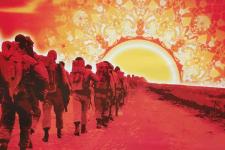 |
| In Iran, every city has a martyrs’ cemetery. Enlarge photo |
 |
| The tombs of the unknown soldiers give mothers whose sons were never found a place to grieve. Enlarge photo |
 |
| How has the loss of this boy’s father shaped his world view? Enlarge photo |
 |
| Could be anywhere: A mother and her son. Enlarge photo |
One of the most powerful experiences of our Iranian trip was a visit to a martyrs’ cemetery. War cemeteries always seem to come with a healthy dose of God — as if dying for God and country makes a soldier’s death more meaningful than just dying for country. That is certainly true at Iran’s many martyr cemeteries. While there are no solid figures, most estimates are that there were over a million casualties in the Iran-Iraq War. Each Iranian city has a vast martyrs’ cemetery.
Iran considers anyone who dies defending the country a martyr and a hero. At the Esfahan cemetery, tombs seemed to go on forever, and each one had a portrait of the martyr and flew a green-and-red Iranian flag. A steady wind blew on the day of our visit, which added a stirring quality to the scene. And the place was bustling with people — all mourning their lost loved ones as if it happened a year ago rather than twenty. The cemetery had a quiet dignity, and — while I felt a bit awkward at first (being part of an American crew with a big TV camera rolling) — people either ignored us or made us feel welcome here.
We met two families sharing a dinner on one tomb. (One of the fathers insisted we join them for a little food.) They met each other twenty years ago while visiting their sons — who were buried side by side. They became friends, their surviving children married, and they come regularly to share a meal on the tombs of their sons.
A few yards away, a long row of white tombs stretched into the distance, with only one figure interrupting the visual rhythm the receding tombs created. It was a mother cloaked in black sitting on her son’s tomb — a pyramid of maternal sorrow — praying.
Nearby was a different area — marble slabs without upright stones, flags, or photos. This zone had the greatest concentration of mothers. My friend explained these slabs marked bodies of unidentified heroes. Mothers whose sons were never found came here to mourn.
I left the cemetery sorting through a jumble of thoughts:
- How oceans of blood were shed by both sides in the Iran-Iraq War — a war of aggression waged by Saddam Hussein and Iraq against Iran.
- How this mighty and historic nation’s national museum of archeology in Tehran was so humble (when I asked about this, the curator explained that the art treasures of his country were scattered in museums everywhere but in Iran).
- How an Iranian woman had crossed the street to look me in the eye and tell me, “We are proud, we are united, and we are strong. When you go home, please tell the truth.”
- How this society — all the delightful little shops, young people with lofty career aspirations, gorgeous young adults with groomed eyebrows and perfect nose jobs, hope, progress, hard work, and gentle people I met over ten days in Iran — could so easily and quickly be turned into an Iraq-style hell of dysfunctional cities, torn-apart families, wailing mothers, newly empowered clerics, and radicalized people.
My visit to the cemetery drove home a feeling that had been percolating throughout my trip. There are many things that Americans justifiably find outrageous about the Iranian government — from denying the Holocaust and making threats against Israel; to oppressing women and gay people; to asserting their right to join the world nuclear club.
And yet, no matter how strongly we want to see our beliefs and values prevail in Iran, we need to understand the 70 million people who live here. What if the saber-rattling coming out of Washington (and the campaign trail) doesn’t coerce this country into compliance? In the past, other powerful nations have underestimated Iran’s willingness to be pulverized in a war…and both Iran and their enemies have paid the price.
In the coming months and years, I believe smart and determined diplomacy can keep the Iranians — and us — from having to build giant new cemeteries for the next generation’s war dead. That doesn’t mean “giving in” to Iran…it means war is a failure and we need to find an alternative. If this all sounds too idealistic, or even naive…try coming to Iran and meeting these people face-to-face.







